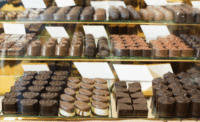Could candy help screen for COVID-19?
Researchers at Ohio State University will use single-color candy in multiple flavors to test for loss of smell — a common COVID-19 symptom.

Could hard candy be used to screen for COVID-19? Researchers at Ohio State University are hoping to find out.
They recently received $305,000 in National Institutes of Health funding in a competitive bid to develop easy-to-deploy strategies that can identify people who are potentially infected with SARS-CoV-2.
The study will ask participants to smell and taste eight different hard candies, which will all be one color but different flavors.
Loss of smell is a common initial symptom of COVID-19, with 86 percent of people who test positive reporting it. The hope is that the setup will make it easy to see who is experiencing that. Ideally, it also will help detect cases in people who have no other symptoms.
Asking people to identify flavors by smelling and tasting the candies allows for sophisticated assessment of the function of two routes – via the nose and the back of the throat – by which our sense of smell helps tell us what we’re eating, explains Christopher Simons, associate professor of food science and technology at Ohio State, in an Ohio State University article about the study.
Plus, the sweet treat is hard to resist as a scientific screening tool.
“Who doesn’t like candy? It’s an ideal stimulus because for this to work, people have to want to do it,” Simons said
If candy initially proves to be effective for screening, researchers will recruit participants who will be asked to sniff and consume a piece of hard candy once per day and log into an app to report what they smell and taste – not only by identifying the flavor, but also rating its intensity. If they report a sudden drop in either sense, they’ll receive a message that they should quarantine and get a COVID-19 test.
Simons has personal experience with COVID-19 symptoms. His entire family tested positive for SARS-CoV-2 in March after a trip to Spain before the borders closed.
“As his family raved about how good the Spanish food tasted, Simons was less impressed. But it wasn’t until he couldn’t detect the flavor of his cocktail back in Columbus that he realized he had lost his sense of smell – which ended up being his only symptom,” the Ohio State article said.
If candy proves effective, it could be a less expensive and more sustainable screening for loss of smell than the ones currently in use, which include a scratch-and-sniff card for smell and/or a one-time evaluation of the bitter medication quinine for taste.
“Quinine isn’t long-term. No one will sip on that every day,” Simons said. “We see factors that potentially indicate our method will be a long-term effective tool for long-term tracking of sensitivity.”
Simons’ lab in the College of Food, Agricultural and Environmental Sciences focuses on understanding the neural and physiological underpinnings of how we perceive food. The research team also includes taste biologist Susan Travers, professor of biosciences in the College of Dentistry, and Kai Zhao, associate professor of otolaryngology in the College of Medicine, who specializes in olfaction – the sense of smell. The new funding is a competitive revision to one of Travers’ existing NIH grants.
Looking for a reprint of this article?
From high-res PDFs to custom plaques, order your copy today!









